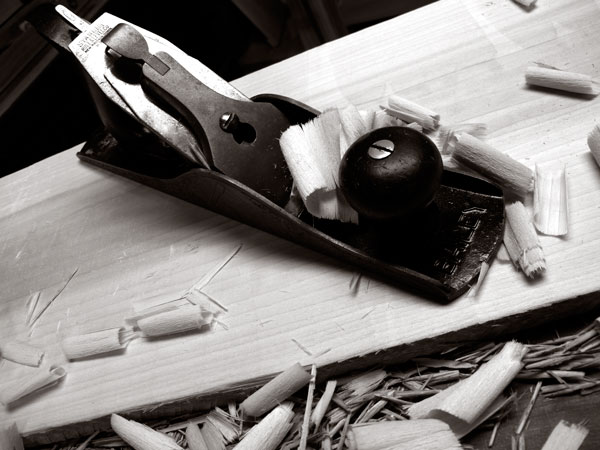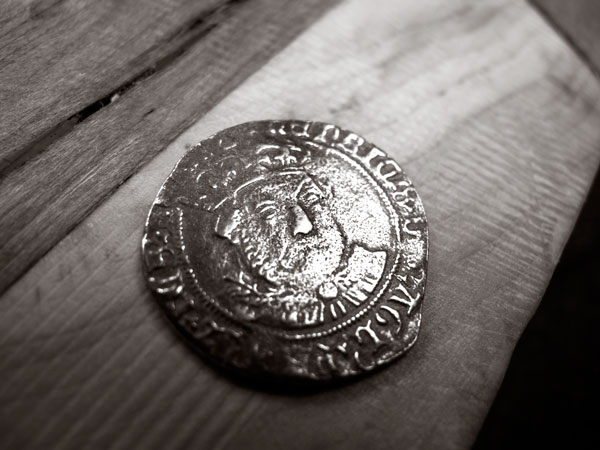We may receive a commission when you use our affiliate links. However, this does not impact our recommendations.
When it comes to pushing our handplanes, I think we are candy-bottomed wussies compared to the joiners of the 17th century.
We are obsessed with how thin a shaving we can make. Early joiners, however, wanted to take the thickest, gnarliest shaving possible for the tool, the bench and his or her arms. For proof, take a look at the first English-language woodworking book, “The Art of Joinery” (1678) by Joseph Moxon.
Moxon says:
But if you ask me how rank your Iron ought to be ſet? I anſwer, If your Wood be ſoft, and your Stuff free, and frowy, that is, evenly temper’d all the way, you may ſet the Iron to take a ſhaving off the thickneſs of an old coined Shilling, but ſcarce thicker; whereas, if your Stuff be hard, or curling, or knotty, you ſhall ſcarce be able to take a ſhaving off the thickneſs of an old Groat. Therefore you muſt examine the Temper of your Stuff, by eaſy Trials, how the Plane will work upon it, and ſet your Iron accordingly. And obſerve this as a General Rule, that the Iron of the Fore-Plane is, for the firſt working with it, to be ſet as rank as you can make good work with; and that for ſpeed fake.
Allow me to translate. Take a shaving the thickness of an “old coined shilling” when the wood is easy to plane. Take a shaving the thickness of an “old groat” when the wood is tough.
Sounds great, but how thick a shaving is he talking about? About five years ago I started pestering collectors of old English coins until I got my answer. An “old coined shilling,” was likely a Commonwealth shilling, which was about .040” thick. An old groat was likely a Charles II groat, which was about .024” thick.
I published these numbers in my reprint of “The Art of Joinery” and didn’t give it much more thought until today, when I found a reproduction of an old groat in my desk. Some woodworker somewhere handed it to me; I honestly cannot say when or where. But something made me take the groat down to my shop to see if I could make a shaving as thick as this coin.
I measured the reproduction groat with calipers, which was about .040” thick.
I began my experiment with some dry American white oak, which I planed with a heavily cambered jack plane. After traversing the grain, I couldn’t get anything thicker than .020” without jamming the tool in the wood or pushing the workbench across the floor.
That’s not nearly as thick as a (reproduction) groat, and I felt like a wus.
So I grabbed some tulip poplar from my wood rack and tried to see how thick a shaving I could manage with the same plane and with traversing. I got up to a .035”-thick shaving when the workbench began to back away rapidly from me. (This, by the way, is why I prefer my bench against the wall.)
But still, I was short of the .040” thickness, which is a fat 1/32”. That’s a lot of wood to remove in one stroke. And this made me wonder if I should perhaps start lifting weights, or perhaps the wood Moxon was talking about wasn’t fully seasoned, like mine is.
Time to start poking around the woodpile and to handplane some firewood.
— Christopher Schwarz
Here are some supplies and tools we find essential in our everyday work around the shop. We may receive a commission from sales referred by our links; however, we have carefully selected these products for their usefulness and quality.










Groat smoat so long as he loves his Mother. I tried with an actual worn old English period coin that Tim Nagle sent me. I am still confused. Elsewhere Moxon refers to the thickness of a worn shilling when describing the amount of peg offset in a drawbored mortise an tenon. That did not work either. To add to the confusion we too often overlook that Moxon wrote about house joinery not fine furniture. After the Great Fire of 1666 London needed a tremendous amount of buildings.Indeed that may have been the imputus for Moxon’s so so serial publication. I gave it up and experimented with different peg offsets. And, yes I have an up to date Starrett. But even though I diddle with reproducing 17 C furniture, I don’t try to measure shaveing thickness. Examining period 17C furniture it is clear they were all over the place. I recall Follansbee and I exmined a chest at Williamsburg presumably made by a Master’s shop. The panels had been planed when they still contained excessive moisture. Their surface looked like moon surface. I would like to hear from Peter on this subject.
Jennie
on a trip to southern Mexico three years ago, I visited several cabinet shops out of die-hard woodworker curiosity about haw shops function there. Electricity was expensive, and power tools beyond a shop built tablesaw/morticer were non-existant. Everything was surfaced with handplanes in open-air workshops. The cabinetry was all mortice and teneon faceframe construction, nicely executed. Our fishing guide was the contractor for several american homeowners and showed us the finished product in beachfront homes. Wood was cut, seasoned in the open air for six months, and then used. The 90 percent humidity ensured that “dry” meant no longer dripping. And the scrub-plane shavings were easily as thick as a dime, when they began cleaning rough stock. The predominant woods were pine and some form of palm.
Any chance he could have meant old groat like the grain? An old dried up unprocessed oat?
… “I got up to a .035”-thick shaving when the workbench began to back away rapidly from me. “…
Was that your FORP bench that moved?
Then again you are a professional writer and an “amateur” woodworker. You did not apprentice starting at age 10-12 YO, pushing a plane day in day out to dress lumber so a journeyman or master craftsman could produce fine furniture.
Yeah, wimp is the term that comes to mind. Sister Tabitha Babbit’s invention of the circular saw and other developments that followed have changed the brute muscled grunts of yore to the high pitched whine of the modern wood shop.
Dan
“… and your Stuff free…”
Chris, did you ensure you were wearing boxers? If not, that might be your problem.
Chris,
When Moxon mentioned an “old” groat, he may very well have meant one that had seen long hard use and was considerably thinner than a freshly struck coin. Coins do take a beating in day to day use. It was very common for people to shave the edges with a knife to accumulate silver bit by bit, as it were.
“…..or perhaps the wood Moxon was talking about wasn’t fully seasoned, like mine is.”
I very much doubt that Moxon was being as precise and scientific as you assume. Perhaps his points were meant in a less literal way, not one requiring micrometer measurements. We moderns do obsess about scientific precision in ways that I doubt would concern the typical 17th century joiner.
Is it possible that the thicker shavings were made possible by the use of greener wood than we are used to using today?